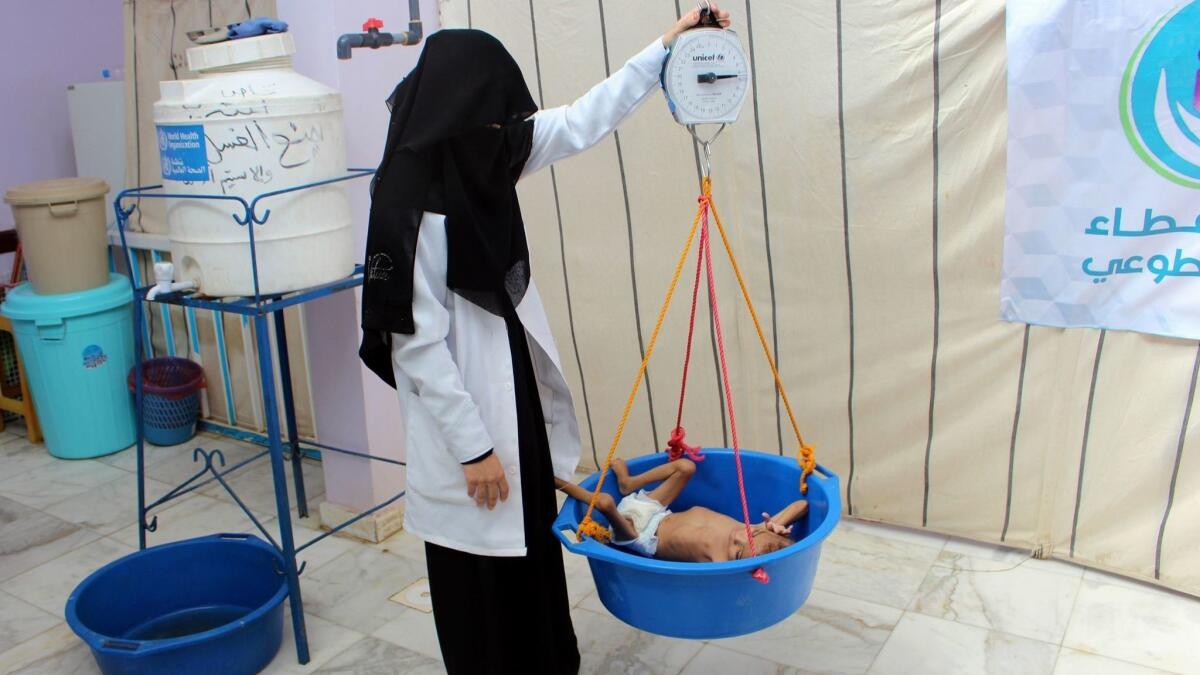Civilian casualties likely to mount in Yemen, rights groups warn

Reporting from Beirut — Days after the Trump administration issued a call for a cease-fire in Yemen’s protracted civil war, humanitarian organizations warned of the likelihood of severe escalation in civilian casualties, particularly in the port city of Hudaydah.
Combat in the Houthi rebel-controlled city and surrounding area -- including ground fighting and airstrikes by a U.S.-supported Saudi-led coalition that is fighting the Iran-backed rebels -- has been ongoing since December 2017.
But the fighting has intensified, even as U.S. officials called last week for a cessation of hostilities and for the warring parties to join in peace talks before the end of November. On Saturday alone, more than 200 airstrikes were reported in and around Hudaydah, according to the European Commission’s directorate-general for European Civil Protection and Humanitarian Aid Operations.
As the country’s major port on the Red Sea, Hudaydah served as the entry point for 85% of Yemen’s food imports before the civil war, according to the World Health Organization.
WHO officials said the new surge of conflict in the area is having an impact on the strategic port and has further increased the threat of famine in the country, where 14 million people — about half the population — are facing pre-famine conditions, according to United Nations officials.
The growing problem of hunger in Yemen was brought into sharp relief last month when a New York Times photograph of emaciated 7-year-old Amal Hussain lying in a hospital bed in northern Yemen went viral. The newspaper reported days later that the girl died.
The WHO said in a statement Thursday that the fighting in Hudaydah is “placing tens of thousands of already vulnerable people at risk, and preventing WHO from reaching them with the help they urgently need.”
The organization noted that half the country’s health facilities are already out of commission.
In recent days, clashes have erupted near health centers, causing service interruptions. The International Committee of the Red Cross said that the city’s largest hospital, Al Thawra, is “mere meters from the front-line, and if more health structures are rendered dysfunctional, the remaining facilities might not have the capacity to provide regular services or cope with an influx of casualties.”
Amnesty International said in a report released Wednesday that Houthi fighters had taken over another hospital, raising fears of Saudi-led attacks that could result in further casualties among patients and staffers inside.
The organization said that Houthi fighters had occupied a hospital in Hudaydah’s May 22 district on Nov. 2 and taken up positions on its roof. Locals said the fighters had been coming and going since that day.
Samah Hadid, Amnesty’s Middle East director of Campaigns, said the development could threaten the lives of dozens of civilian patients, as well as medical workers.
“The presence of Houthi fighters on the hospital’s roof violates international humanitarian law, but this violation does not make the hospital and the patients and medical staff lawful targets for Saudi Arabia and UAE-led Coalition air strikes,” he said in a statement. “The hospital is full of injured civilians who have nowhere else to go for lifesaving medical care. Anyone attacking a hospital under these conditions risks responsibility for war crimes.”
Amnesty International also reported that it had documented airstrikes on civilian targets in Hudaydah and the surrounding area by the Saudi-led coalition; including on a Houthi checkpoint through which a stream of civilian traffic was passing, and on a vegetable market in Bayt al Faqih.
The Houthis, in turn, have responded to the military advance on the city with mortar fire, “which is notoriously imprecise and should never be used in populated areas,” the report said. “This tactic is also claiming an increasing number of civilian lives.”
More than half of Hudaydah’s prewar population of 600,000 has fled, according to the International Organization for Migration. But with many escape routes blocked or destroyed, aid workers said tens of thousands of civilians are now trapped in the city in the face of escalating conflict.
Amid the escalating violence, U.S. Secretary of State Mike Pompeo and Secretary of Defense James N. Mattis last week called for all parties to join in a peace process.
The Saudi kingdom has come under increased scrutiny in the wake of the killing of Jamal Khashoggi by Saudi agents, and in the United States, Congress has stepped up pressure on the Trump administration to curtail U.S. support for Saudi military operations in Yemen.
Within 30 days, Mattis said, “we want to see everybody around a peace table based on a cease-fire.”
So far, the calls for a cease-fire have not produced results. Rebel leader Abdul-Malek al-Houthi, in a televised speech Wednesday, said attacks by the Saudi coalition are up, and he accused the United States of hypocrisy.
“The military escalation on the west coast came after the U.S. calls to stop the war in Yemen, and the level of the field does not predict readiness for peace and dialogue,” Houthi said.
Meanwhile, aid organizations called for restraint.
“Hudaydah is once again trapped in violence with hundreds of thousands of Yemenis caught in the middle,” said Fabrizio Carboni, International Committee of the Red Cross regional director for the Near and Middle East. “The upcoming talks cannot be an excuse to disregard the laws of war that protect the lives of the Yemeni people.”
Sewell is a special correspondent.
UPDATES:
1 p.m.: The wire story has been replaced with staff reporting.
The article was originally published at 9:32 a.m.
More to Read
Sign up for Essential California
The most important California stories and recommendations in your inbox every morning.
You may occasionally receive promotional content from the Los Angeles Times.











